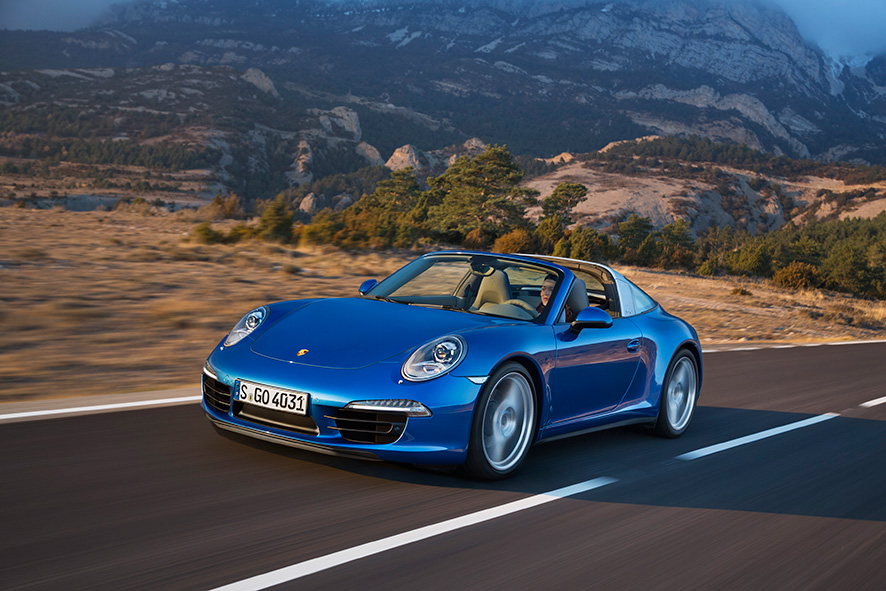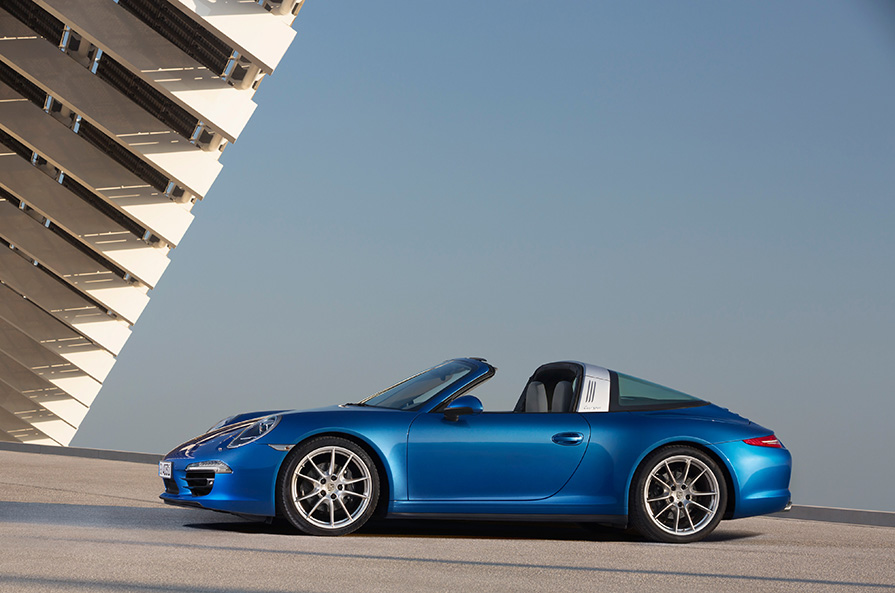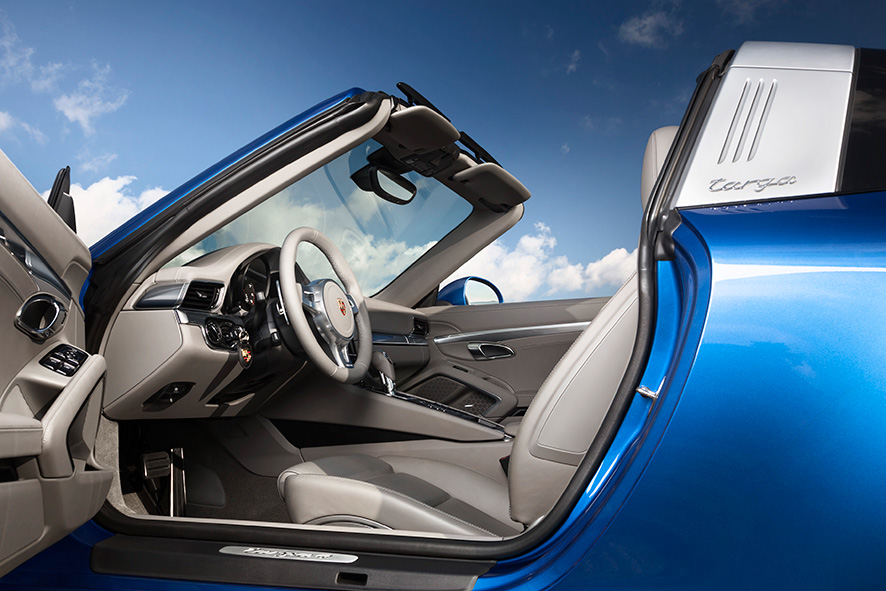Porsche 911 Targa review (2014-on)
A retro ride concealing some neat engineering

What is the Porsche 911 Targa?
Welcome to the Targa, Porsche’s most retro ride and a throwback to the days of the Farrah Fawcett hairstyle when Sergeant Pepper’s Lonely Hearts Club Band played on turntables around the world, and Paul Newman was resisting law and order in Cool Hand Luke.
Originally conceived in the mid 1960s as a way to sell a convertible type of car in America, while satisfying new legislation concerning safety in the event of a car rolling over, the Targa is a halfway house between a fully open convertible and a closed coupé.
At present it is only sold with Porsche’s four-wheel drive system, and is offered with a choice of two engines: a 3.4-litre or 3.8-litre, both in Porsche’s classic flat-six configuration. Driving’s pick would be the 3.8-litre, known as the Targa 4S.
Prices start from £86,377 for the Targa 4 and £96,413 for the Targa 4S.
One of the main options is an automated manual gearbox, or PDK in Porsche speak. It is a twin-clutch system that, on paper at least, improves the performance of the car (more on that later).
Click here to search for used Porsche 911
There isn’t anything quite like the Targa on the market at this price level – other cars are traditional convertibles – so depending on your view, Porsche either has a unique selling proposition or has reinvented a gimmick. We like to think it’s the former.
Drivers who have a £100,000 cheque ready to be handed to a salesman should also test drive the Mercedes SL. It’s one of the few cars that has been touring the likes of the Cap Ferrat for longer than the 911.
Also consider the Aston Martin Vantage Roadster, Audi R8 Spyder, Jaguar F-type R and Maserati Gran Cabrio. The test drives will be fun but choosing between them will be a tough decision.
The drive
Before we get to the drive, let’s start with the roof. The original Targa of the 1960s involved plenty of manual labour – not to mention cursing under your breath – if there wasn’t someone else around to help lift out the roof when the sun was shining. The 2014 911 Targa requires nothing more taxing than applying an index finger to a button next to the gearstick.
Electric motors lift up the expansive rear window and part of the bodywork, and drop the single piece section back behind the car. Then the fabric covered roof panel is propelled back behind the seats and the rear window raises to encase it. The whole event is a crowd-pleasing spectacle.
Just 19 seconds later (we timed it) you’re ready to catch some rays while singing along to California Girls and listening to the yowl of the engine and exhaust, especially if the exhaust is set to the more vocal Sports mode.
A word of warning, however. The window and body section extends some way beyond the back bumper of the car, something that’s all too easy to forget. Park too close to a wall or garage door and there’s every possibility of suffering that sinking feeling when you hear the inevitable crunch.
With the roof down, there is a surprising amount of wind noise at main road speeds. More so, say, than in a 911 cabriolet. Presumably, this is due to the air flow being interrupted by the roll-over bar and rear window. With it closed, the car is almost as snug and refined as a coupé.
Whether open or closed, there’s little trace of flex in the structure – the Targa’s body feels as buff as a younger Arnie Schwarzenegger. This means the rest of the driving position is faithful to the 911 coupé.

Driving tested the Targa 4. The 3.4-litre, naturally aspirated flat-six cylinder engine can seem a little flat at times. Below about 5,500rpm it feels slightly sleepy and needs winding up to enjoy the full thrust of its 345bhp. Our pick would be the 3.8-litre S version which has 394bhp and feels appreciably more muscular in day-to-day driving. But the 3.4 is tractable, makes a distinctive noise and works well with the PDK transmission, even achieving a shade over 29mpg during a 50-mile commute from Kent to the centre of London. That’s impressive.
The automated transmission is smooth in Drive and quick-shifting whether in Drive or Manual, but it’s a shame the sound of the engine and exhaust are pretty much drowned out by the roof-down wind noise at main road speeds. We’d prefer the manual gearbox, if only to save a bit of cash and get more involved in the driving experience.
Fitted as standard with four-wheel drive, the Targa offers surefooted road-holding. For most of the time, power is sent to the rear wheels (you can see as much by selecting the relevant graphic on an information screen next to the rev counter) and the car displays all the telltale signs of the 911. It bobs about ever so slightly as you corner on a bumpy road, like a dancer shaking their hips.
Switch off the stability control systems and attempt to drive like Walter Röhrl – the two-time world rally champion who is now one of Porsche’s chief test drivers – and you can use the 911’s rear weight bias to your advantage. On a clear, open bend, lifting off the throttle eases the tail round gently, and applying the throttle results in a satisfying four-wheel drift as the electronics somehow balance the perfect level of power between the front and rear wheels.
It remains one of the most satisfying sports cars for the keen driver, but perhaps not the most relaxing to live with if all you want to do is cruise.
The interior

Like the coupé and cabriolet versions of the 911, the Targa is a 2+2. Meaning? There is space for two adults in the front and two young children in the back. An adult can fit in the back only by sitting astride both seats, and even then it’s about as comfortable as trying to fit yourself into a shoe box. Consider the back seats as space for handbags, manbags or shopping bags and you won’t be disappointed.
There is also a boot, although it’s located under the bonnet. With 125 litres of luggage capacity, this is not the car for weekend visits to the garden centre. Stick to trips to the South of France. With a 68-litre fuel tank, hidden in the nose of the car, there is a potential touring range of 485 miles (in the automatic model).
The design of the dashboard is faithful to the look of the original 1960s 911, but the number of gadgets and gizmos has increased. The quality is impressive; this car feels built to last. But the plethora of buttons around the transmission tunnel is far from intuitive and requires the driver to take their eyes from the road.
The driving position is comfortable, and the Targa’s extra large rear window means that all-round visibility is excellent – a significant advantage over the 911 cabriolet.
Click here to search for used Porsche 911
The one to buy
Porsche 911 Targa 4S
Specifications
Price: From ££96,413 (correct at first publication)
Engine: 3800cc, flat-six-cylinder petrol
Power: 394bhp @ 7400rpm
Torque: 324 lb ft @ 5600rpm
Transmission: 7-speed manual, four-wheel drive
Acceleration: 0-62mph in 4.8sec
Top speed: 182mph
Fuel: 28.2mpg (combined)
CO2: 237g/km
Road tax band: L
Dimensions: L 4491mm, W 1852mm, H 1291mm




